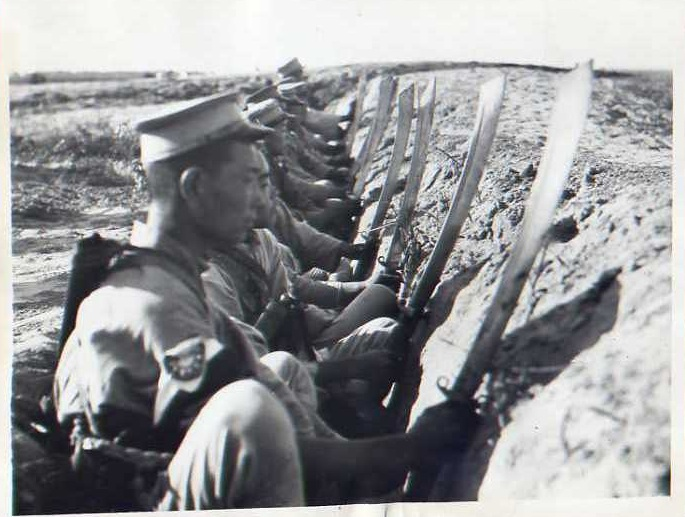As I've said before the "Escalate Sino-Japanese war" mechanic is a stitch to cover up for the 200+% excessive speed infantry has.
As to the Sino-Japanese war in total, it's probably the most interesting campaign of all.
The Battle of Shanghai alone had 1,000,000 combatants in total in 1937 but nobody outside of China knows much about it.
If someone has tables of equipment and order of battle for 1936 Chinese (Kuomintang, Communist, Warlord) factions I would love to see it. Russian & English literature has very limited data on the subject.
(Google translate)
如果有人有1936年中国(国民党、共产党、军阀)各派系的装备和战斗序列表,我很想看看。俄英文献中关于这方面的资料非常有限。
My understanding is that Kuomintang China was not actually united, but rather a disjointed coalition of various warlords partially controlled by Chiang Kai-Shek and his Whampoa military academy graduates.
The Xian incident, when Chiang Kai-Shek was arrested by the ex-Manchurian warlord Zhang Xueliang kind of shows that. The ex-Fengtian/Xueliang troops were directed to fight the Communist Chinese, but instead "put on a show" and arrested their "Supreme leader Chiang" upon arrival to inspect them.
The only certain parts of the Army Chiang Kai-Shek actually fully controlled were 2-3 divisions trained by the German military advisors: 88th, 87th and 36th, and even there, these "Elite units with purchased Czech machine guns, German artillery and German/British tanks" lacked something as simple as bayonets!
The rest of the army OOB is something I would like to know: my understanding was it was a mix of "Sword + Grenade armed" troops like this:
As well as "Elite" Regional troops equipped by Warlords/Regional Governors, with rifles & machine guns, often trained by foreign instructors. Artillery was basically nonexistent, to my knowledge less than 300 artillery pieces in all of Chine in 1936 (Spain in 1936 pre-Civil war had about the same number, compare China to Spain lol).
At the same, Japan had a bunch of warmongering mid-level officers that wanted to capture another part of China, like they did with Manchuria and attempted in Shanghai in 1931. Civil authorities were against war, but couldn't control their own army (and were subject to military coups).
As a result, the Japanese Army staged the Marco Polo bridge incident, while the Navy staged another incident in Shanghai which they used as reasons to justify aggression. Japanese civil authorities tried to deescalate, but soon discovered that their diplomatic communication was deciphered by the military, which was continuing to provoke war.
At the same time, unlike in HOI4, the Japanese already had beachhead secured in Shanghai (in HOI4 it is fully Chinese controlled and not even demilitarized unlike what was the case after 1931), where their marines were stationed in fortified positions basing on Japanese government-sponsored Zaibatsu factories. Chiang Kai-Shek knew this, he tried to destroy the beachhead by an all-out attack of his elite German-trained divisions, but instead simply lost them in "Forced attacks" on Japanese fortifications.
Japanese then landed new troops, pushed forward, took Chiang's capital and expected:
A) Either the war ends in Chiang surrendering coastal territories to Japan, like he did with a piece of Shanghai and Manchuria
B) Chiang Kai Shek's loss of his "Praetorian guard" and authority will lead to China disintegrating back into warlorships/cliques that are easy to crush one by one.
Partially that did happen, for example the Shandong governor, I believe, turtled in place instead of retreating by Chiang's order, in hopes of getting a separate agreement with Japan. He was destroyed.
But in reality neither of the two would happen.
And not only that, Soviets started sending massive military aid and volunteers to the Kuomintang (despite very sour relations after Chiang's communist purges in the late 1920s).
What happened after that is kind of a mystery, in short, Japanese tried to setup a puppet government of China, tried destroying main Chinese forces but in the end they simply were forced to defend their territorial gains in hopes of eventually forcing Chiang's government to peace talks.
They had armament superiority, while the Chinese simply had manpower as well as guerillas in the Japanese rear. As well, Chiang Kai-Shek understood that even after he defeats the Japanese he will still have to face other warlords and communists (that could gain power from USSR support and through setting up guerillas in ex-Kuomintang territory), so he was trying to balance "Internal war" with "External war".
From a plausibility standpoint there was no "Escalation", first it was a "rogue military operation", then when its initial phase "succeeded" it became a classic "limited war" mixed with a "unannounced Chinese civil war".
Given Japan had resources to occupy Indochina and fight the US later, they probably could have directed those resources to China, but it seems they simply didn't see a need to make "a finishing blow" or on the contrary, didn't see it possible. At least not until 1943+, when they became desperate.
At least that's what I gathered, could be very wrong though. Not a Mandarin speaker.

